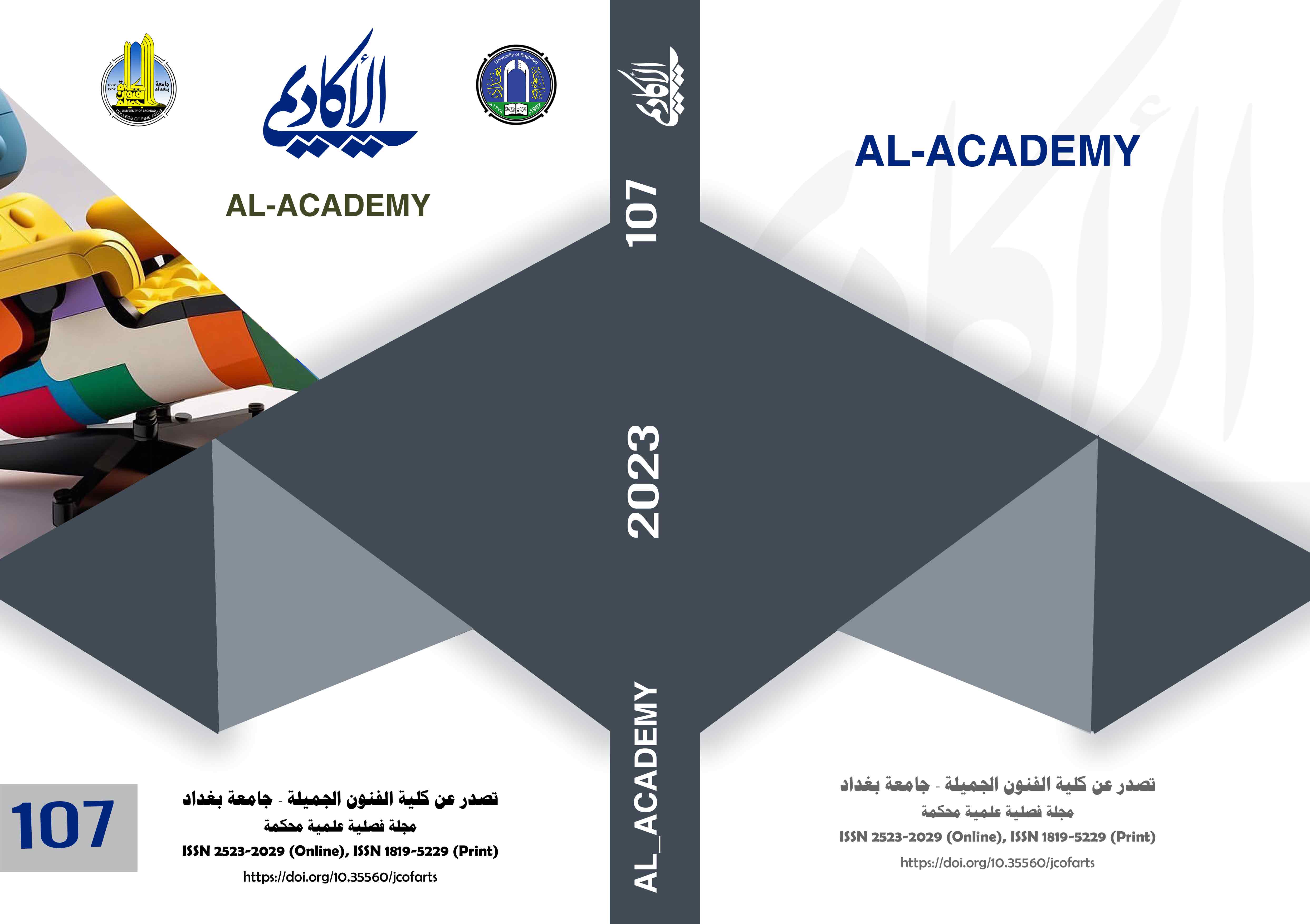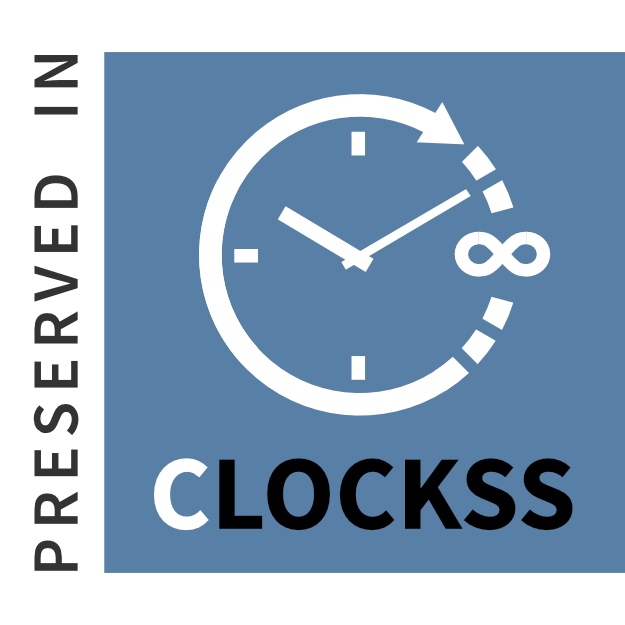Functional variables of responsive materials in product design
DOI:
https://doi.org/10.35560/jcofarts107/345-366Keywords:
Functional variables, responsive materials, industrial productAbstract
The research discussed the topic of the functional role of responsive materials in being elements of a functional transformation in the design of industrial products, based on the study of the structures of smart materials and their performance capabilities at the level of action and self-reaction that characterize this type of materials.
Basic features of responsive materials have been identified to be elements of self-functional insertion into the industrial product design, which contributes to raising the efficiency and functional capacity of the industrial product and enhancing the ability of products to perform self-acting interactions in the structural structure of the material structure of the product and its ability to respond and interact with context variables. environmental.
The responsive materials were classified into: electrical insulating materials, ceramics, piezoelectric polymers, shape memory alloys, shape memory polymers, thermoelectric materials, and electrical and magnetic fluids. And according to the cognitive propositions of research and discussion of methods and types of performance application of the characteristics of self-response materials in the design of industrial products that have the ability to self-response, a number of scientific conclusions were reached, which were, in their entirety, a scientific analysis of what and how of the design application of the characteristics of responsive materials in creating new functions in Industrial product design.
References
Abbas, Q. W. (2016). Metaphor in product design. Al-academy Journal(76), 123-136.
Addington, M., & Schodek, D. (2005). Smart materials and technologies for the architecture and design professions. Burlington: Architectural Press.
AKIN, T. (2009). Communication Of Smart Materials: Bridging The Gap Between Material Innovation And Product Design. Master Of Science, Turkey: he Graduate School Of Natural And Applied Sciences Of Middle East Technical University.
Aktaş, B., & Mäkelä, M. (2019). Negotiation between the maker and material: Observations on. International Journal of Design, 13(2), 55-67.
Al-Baldawi, M. (2015). Application of Smart Materials in the Interior Design of Smart Houses. Civil and Environmental Research, 7(2), 1-16.
Aluqaily, J. K., & Abbood, A. N. (2020). Biophysics and its scientific data in industrial product design. Al-academy Journal(96), 289-306.
Aluqaily, j. k., & Mahmood, S. n. (2015). Pleasure and Emotions and their role in aesthetics' experience of the user. Al-academy Journal(71), 165-184.
AlUqaily, j. k., & Matar, A. G. (2019). Ecological Aesthetics of Industrial Product in Urban Design. Al-academy Journal(93), 2523-2029.
Baumberger, G. (2007). Methods for customer-specific product definition for individualized products. Munich: Technical University of Munich.
Baurley, S. (2004, July). Interactive and experiential design in smart textile products and applications. Personal and Ubiquitous Computing, 8(3-4), 274-281.
Brinson, L., & Huang, M. (1996). Simplifications and comparisons of shape memory alloy constitutive models. Journal of Intelligent Material Systems and Structures, 7(1), 108–114.
Champier, D. (2017). Thermoelectric generators: A review of applications. Energy Conversion and Management, 140, 62–181.
Chen, G., Dresselhaus, M., Dresselhaus, G., Fleurial, J., & Caillat, T. (2003). Recent developments in thermoelectric materials. International Materials Reviews, 48(1), 45–66.
Crawley, E. (2004). The Influence of Architecture in Engineering Systems. MIT Engineering Systems Symposium.
Disalvo, F. (1999). Thermoelectric Cooling and Power Generation. Science, 285(5428), 703–706.
General Motors. (2014, febreuary 12). Chevrolet Debuts Lightweight ‘Smart Material’ on Corvette: GM’s first use of heat-activated shape memory alloy replaces heavier motorized part. Retrieved April 7, 2022, from General Motors corporate news room: https://media.gm.com/media/us/en/gm/home.detail.html/content/Pages/news/us/en/2013/Feb/0212-corvette.html
Granzow, T., Glinsek, S., & Defay, E. (2022). Piezoelectric Ceramics (Vol. 4). (A.-G. Olabi, Ed.) Elsevier.
Guo, Y., Liu, L., Liu, Y., & Leng, J. (2021). Review of Dielectric Elastomer Actuators and Their. Advanced Intelligent Systems, 3(2000282), 1-18.
Hodgson, S., & Harper, S. (2004). Effective use of materials in the design process: More than a selection problem. the 7th International Conference on Engineering and Product Design Education. Delft, the Netherlands: Delft university.
Jolly, M., Bender, J., & Carlson, J. (1999). Properties and applications of commercial magnetorheological fluids. Journal of Intelligent Material Systems and Structures, 10(1), 5–13.
Kofod, G., & Wirges, M. (2007). Energy minimization for self-organized structure formation and actuation. Appl. Phys. Lett, 90(081916).
Kumar, S. (2022). Thermal Engineering (Vol. 1). Gewerbestrasse, Switzerland: Springer.
Mäkelä, M., & Löytönen , T. (2017). Rethinking materialities in higher education. Art, Design & Communication in Higher Education, 16(2), 241-58.
MICOCCI, M., SPINELLI, G., & AJOVALASIT, M. (2016). Actualizing Agency through Smart Products: Smart Materials and Metaphors in Support of the Ageing Population. 6th STS Italia Conference (pp. 1-17). Trento: Sociotechnical Environments.
Mitrovic, M., Carman, G., & Straub, F. (2001). Response of piezoelectric stack actuators under combined electro-mechanical loading. International journal of solids and structures, 38(24), 4357–4374.
Monkman, G. (2000). Advances in Shape Memory Polymer Actuation. Mechatronics, 10(4-5), 489–498.
Mühlhäuser, M. (2007). Smart products: An introduction. (M. Mühlhäuser, A. Ferscha, & E. Aitenbichler, Eds.) Berlin, Germany: Springer.
Newnham, R., & Gregory, R. (1991). Smart Electroceramics. Journal of the American Ceramic Society, 47(3), 463-480.
Olson, G. (2000). Materials by Design: Efficient Innovation. Pathways of Discovery, 288(5468), 993- 998.
Park, J.-K. (2012). Advanced Development of a Smart Material Design, Modeling, and Selection Tool with an Emphasis on Liquid Crystal Elastomers. Ohio, USA: Graduate School of The Ohio State University.
Parliamentary Office of Science and Technology. (2008, January). Smart materials and Systems. (299), 1-4.
Pickering, A. (2005). Practice and posthumanism: Social theory and a history of agency. (S. T, K. K, C. Knorr, & v. E, Eds.) London, UK: Routledge.
Ritter, A. (2007). Smart materials: in architecture, interior architecture and design. Springer.
Rus, D., & Tolley, M. (2015, May 27). Design, fabrication and control of soft robots. Nature, 521(7553), 467–475.
Schwartz, M. (2002). Preface in the smart materials encyclopedia. Canada: John Wiley& Sons.
Sekhar, C., & et al. (2021). Piezoelectricity and Its Applications, Multifunctional Ferroelectric Materials. (D. Ranjan Sahu, Ed.) Namibia: Namibia University of Science and Technology.
shalal, F. A., & Loken, H. K. (2020). The functional dimension of designing bilingual logos. Al-academy Journal(96), 273-288.
Soni, S. (2017). A Review Paper on Hydrophones. International Journal of Engineering Research & Technology (IJERT), 7(23), 1-3.
Thill, C., Etches, J., Bond, I., Potter, K., & Weaver, P. (2008). Morphing skins. The Aeronautical Journal, 112(1129), 117–139.
Ulrich, K. (1995). The Role of Product Architecture in the Manufacturing Firm. Research Policy, 24(3), 419-440.
Wang, Y., & Gupta, N. (2019). A soft gripper of fast speed and low energy consumption. Sci. China Technol. Sci.(62), 31-38.
Wereley, N., Singh, H., & Choi, Y. (2014). Adaptive Magnetorheological Energy Absorbing Mounts for Shock Mitigation. In N. Wereley, Magnetorheology: Advances and Applications (pp. 278-287). Cambridge, UK: Royal Society of Chemistry.
Wissler, M., & Mazza, E. (2005, December ). Modeling and simulation of dielectric elastomer actuators. Smart Materials and Structures, 14(6), 1396–1402.
ELMAHI, Z. (2022). Art as a therapy to relieve symptoms of Attention Deficit/Hyperactivity Disorder (ADHD), in children. Al-Academy, (106), 167–186. https://doi.org/10.35560/jcofarts106/167-186
bint Mohammad AlMutairi, S., & bint Ayed Alharbi , R. (2022). Inventory of Saudi youth trends towards choosing fashion accessories. Al-Academy, (106), 205–230. https://doi.org/10.35560/jcofarts106/205-230
Saleh Moraished, L., & Saleh Al-Saleh, M. (2022). The Relationship Between Using Diverse Materials to the Intellectual Context’s in the Art of Contemporary Ceramic. Al-Academy, (106), 253–270. https://doi.org/10.35560/jcofarts106/253-270
mohammed Alamri, M., & bint Mansour Abdul Aziz aljadid, M. (2022). Printmaking Techniques to Enable People with Visual Impairment to Taste Print Artworks. Al-Academy, (106), 297–318. https://doi.org/10.35560/jcofarts106/297-318
Gharsan Alshehri, H. . (2022). Role Of the Interactive Public Sculpture in Increasing Physical Activity . Al-Academy, (105), 57–80. https://doi.org/10.35560/jcofarts105/57-80
Ibrahim Alhulwah, N. ., Saud Alrasheed, E. ., & Almokhtar Lahyani, S. . (2022). The semiotics of the visual image of women in the discourse of empowerment, Saudi Arabia Kingdom as a model. Al-Academy, (103), 25–42. https://doi.org/10.35560/jcofarts103/25-42
Ahmad allaoui, L. . (2022). Textual thresholds and its Aesthetic in history: "Mamo Zain" by its author, the famous Kurdish poet Sheikh Ahmad Al-Khani, deceased (1118 AH / 707 AD), translated by Sheikh Dr. Muhammad Saeed Ramadan al-Bouti. Research on the connotation and manifestations of interconnection. Al-Academy, (103), 73–92. https://doi.org/10.35560/jcofarts103/73-92
mohamed Dammak, K. (2022). Transformations of the body from traditional expression to subjectivity : Marina Abramivic as a model. Al-Academy, (103), 149–164. https://doi.org/10.35560/jcofarts103/149-164
shafee, wafa H., & aboabat, A. A. (2021). Recycling waste toys to accessories suggested uniform for educational units in kindergarten stages. Al-Academy, (102), 63–80. https://doi.org/10.35560/jcofarts102/63-80
Ebraheem Mongy, Y. ., Amer Al-Hajri, S. ., & Al Mardhoof Al Saadi, N. . (2021). Inspiring heritage and symbols of local identity in contemporary Omani Graphic Art. Al-Academy, (102), 81–104. https://doi.org/10.35560/jcofarts102/81-104
Nasser AL Nahari , N. . (2021). The Role of Contemporary Interactive Art Works Economically and Culturally "An Analytical Study". Al-Academy, (102), 123–144. https://doi.org/10.35560/jcofarts102/123-144
Kalied Talib Alsamurai, A. . (2021). The communicative education of fine arts in the COVID-19 crisis and its manifestations in the modernization of the works of the Iraqi painter "Nabil Ali as a model". Al-Academy, (102), 207–222. https://doi.org/10.35560/jcofarts102/207-222
Daryanavard (al-ghaisi), Z., Balavi, R., & M. Bataineh, A. (2021). The Communicative Functions in The Speech of The UAE National Anthem in The Light of The Eloquence of The Audience. Al-Academy, (101), 145–156. https://doi.org/10.35560/jcofarts101/145-156
Abdullah Al-Qudairi, T. (2021). Designing Clothes that Meet the Functional and Aesthetic Needs of Children with Hip Dislocation. Al-Academy, (101), 157–184. https://doi.org/10.35560/jcofarts101/157-184
Abdulaziz Alfadda, A. (2021). Utilization of Design Principles of Nature in Innovating Contemporary Metal Products. Al-Academy, (101), 203–226. https://doi.org/10.35560/jcofarts101/203-226
Daryanavard, Z., Balavi, R., & Khezri, A. (2021). Semantic functions of repetitive synthesis in Adnan al-Sayegh’s poetry. Al-Academy, (100), 233–246. https://doi.org/10.35560/jcofarts100/233-246
Hassan Abu Hasna, R. (2021). The Utilization of Arabic Calligraphy to Inspire Modern Arabic Type Designs. Al-Academy, (100), 277–304. https://doi.org/10.35560/jcofarts100/277-304
Aldaawani, R. F. (2021). The semiotic of the Islamic blazon - a related analytical study between the Islamic blazon and its publicity message. Al-Academy, (100), 319–336. https://doi.org/10.35560/jcofarts100/319-336
Wafa Hassan, S., & Marram Zaid, A.-H. (2021). Sustainability by recycling palm waste in designing women’s belts. Al-Academy, (100), 337–356. https://doi.org/10.35560/jcofarts100/337-356
Kazem Odeh, R., & Khalaf Hussain, S. (2021). The effectiveness of media communication and its problems in the contemporary theatrical presentation. Al-Academy, (99), 155–168. https://doi.org/10.35560/jcofarts99/155-168
Saud Al-Hazza, H. (2021). Study of the participation of Saudi women in official visual arts exhibitions "Contemporary Saudi Art Exhibition as an Example". Al-Academy, (99), 311–328. https://doi.org/10.35560/jcofarts99/311-328
Ali Ahmed Abdel Rahman, R. (2021). Making use of economical design techniques and materials in implementing cosmetic supplements to the interior spaces of the dwelling. Al-Academy, (99), 329–348. https://doi.org/10.35560/jcofarts99/329-348
Al Saadi, N. (2021). Variables related to the performance styles of batik art to achieve linear tactile effects in the printmaking. Al-Academy, (99), 349–364. https://doi.org/10.35560/jcofarts99/349-364
Saad Algarni, M. (2021). Virtual Art Exhibitions In Times Of The Corona Pandemic. Al-Academy, (99), 441–480. https://doi.org/10.35560/jcofarts99/441-480
Abduljabbar AlEssa, A. (2020). Simulation As One Of The Tools Of Visual Thinking And Its Effect On Developing Drawing And Design Skills To Produce Innovative Artworks. Al-Academy, (98), 235–254. https://doi.org/10.35560/jcofarts98/235-254
Mohammed Al-Mutairi, S., Yousef Altwaijri, B., Yousef Al-Ali, R., & Abdul Hakim Almoqrin, S. (2020). Designing an E-marketing Website for Sustainable Fashion. Al-Academy, (98), 271–286. https://doi.org/10.35560/jcofarts98/271-286
A.A. FEDA, L. (2020). GIRL’S TRADITIONA COSTUME IN MAKKAH AL MUKARRAMAH _ KINGDOM OF SAUDI ARABIA”. Al-Academy, (98), 305–324. https://doi.org/10.35560/jcofarts98/305-324
Abdulhafeez, N. (2020). Novel Coronavirus Pandemic as it is Expressed by Children in Their Drawings On-line: An Analytical Study. Al-Academy, (98), 413–434. https://doi.org/10.35560/jcofarts98/413-434
Almamari, B. M. (2020). Appearance and Decay of Split-brain Theory to Explain Human Artistic Activity: A Historical Review. Al-Academy, (97), 261–270. https://doi.org/10.35560/jcofarts97/261-270
Abdulhafeez, N. (2020). The Philosophy of Beauty and Aesthetic Tasting in the Story of Yusuf, peace be upon him, with the Al-Azeez’s Wife in light of the sayings of Ancient Philosophers and Modernists. Al-Academy, (97), 241–260. https://doi.org/10.35560/jcofarts97/241-260
O Alzahrani, M. (2020). The Image of Women in Arab Media Advertisements. Al-Academy, (97), 299–320. https://doi.org/10.35560/jcofarts97/299-320
Abdulghaffar Feda, L. (2020). Recycling evening dresses into modern dresses with traditional features. Al-Academy, (97), 321–342. https://doi.org/10.35560/jcofarts97/321-342
Saud Alrasheed, E. (2020). Digitization is a contemporary reality and its importance in the Saudi plastic arts. Al-Academy, (96), 213–228. https://doi.org/10.35560/jcofarts96/213-228
Mohammed Alamri, M. (2020). Inspiration Of Typed Paintings From Folk Architecture In Asir Region. Al-Academy, (96), 229–250. https://doi.org/10.35560/jcofarts96/229-250
Murshed Alharbi, M., Alahmad, H., & Alsenan, M. (2020). Saudi society’s trends towards visiting museums and art galleries. Al-Academy, (96), 251–272. https://doi.org/10.35560/jcofarts96/251-272
kadim oda, russil, & fuad fadhel, L. (2020). Techniques of Acting Performance in Fantasy Theatrical Show. Al-Academy, (95), 5–18. https://doi.org/10.35560/jcofarts95/5-18
Mohammed taleb al dweik, S., abu taleb, S., & saber, M. (2020). The Role of the Passive Conditioning in Achieving Thermal Comfort in Temporary Hotel Units. Al-Academy, (95), 243–272. https://doi.org/10.35560/jcofarts95/243-272
Ibrahim Bin Hamdan, N. (2019). Creativity in the Draping on the mannequin of Young Girls Victorian Fashion between 1860-1890. Al-Academy, (94), 73–96. https://doi.org/10.35560/jcofarts94/73-96
Nassar Alajaji, T., & Abdulazez Almogren, H. (2019). The Effect of The Illustration Program on Fashion Design Inspired by Historical Costumes:. Al-Academy, (94), 97–114. https://doi.org/10.35560/jcofarts94/97-114
Nassar Alajaji, T., & Mohammed Alfulaij, W. (2019). Revival of the Heritage Using Porcelain Units Inspired by Traditional Sadou Decoration and Kufic Calligraphy in Fashion Design. Al-Academy, (92), 253–270. https://doi.org/10.35560/jcofarts92/253-270
Nawi, K. (2019). Time in the Cinema.The Two Films (The Knife and The Deceived) -A Model. Al-Academy, (91), 49–64. https://doi.org/10.35560/jcofarts91/49-64
alsayed Mustafa jawad ahmed, B. (2016). The Instagram from a media tool to a marketing tool. Al-Academy, (74), 195–212. https://doi.org/10.35560/jcofarts74/195-212
Khaled Taleb Al Samurai, A. (2018). The educational means used by teachers of art education in primary schools. Al-Academy, (89), 229–240. https://doi.org/10.35560/jcofarts89/229-240
Jassem Mohammed, N., & Taha yaseen, E. (2017). Structural Systems In The Design Of World Magazine Covers. Al-Academy, (86), 149–164. https://doi.org/10.35560/jcofarts86/149-164
al-Khalidi, A. S. (2017). The reality of interior design of Sharjah mosques and the possibility of development - selected models. Al-Academy, (83), 247–267. https://doi.org/10.35560/jcofarts83/247-267
kadim oda, R. (2016). Actor performance features in the types of theatrical silent. Al-Academy, (79), 225–238. https://doi.org/10.35560/jcofarts79/225-238
kadim oda, R. (2016). Indicative coding of the actor’s performance in the Iraqi theater show. Al-Academy, (77), 63–74. https://doi.org/10.35560/jcofarts77/63-74
Allawi Salal, A. ., & Kadim oda, russil. (2022). Actor’s skills in pantomime theater performances. Al-Academy, (105), 121–132. https://doi.org/10.35560/jcofarts105/121-132
kadim oda, russil, & fuad fadhel, L. (2020). Techniques of Acting Performance in Fantasy Theatrical Show. Al-Academy, (95), 5–18. https://doi.org/10.35560/jcofarts95/5-18
Kadim oda, russil, & Khalaf Hussain, S. (2021). The effectiveness of media communication and its problems in the contemporary theatrical presentation. Al-Academy, (99), 155–168. https://doi.org/10.35560/jcofarts99/155-168
Downloads
Published
Issue
Section
License
Copyright (c) 2023 Wameedh Abdul Karim muhsin

This work is licensed under a Creative Commons Attribution 4.0 International License.













